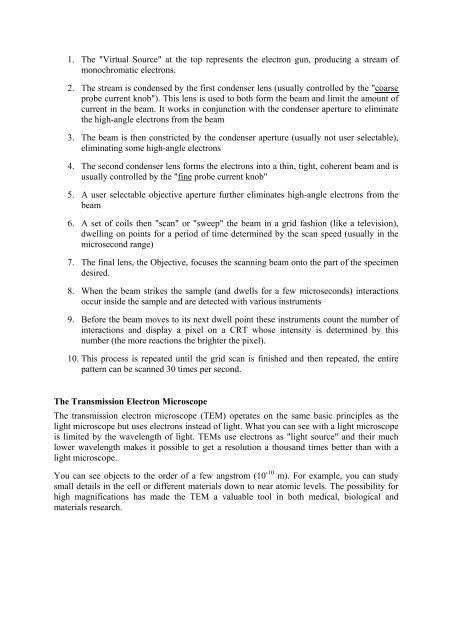1 Úvod:
1 Úvod:
1 Úvod:
Create successful ePaper yourself
Turn your PDF publications into a flip-book with our unique Google optimized e-Paper software.
1. The "Virtual Source" at the top represents the electron gun, producing a stream of<br />
monochromatic electrons.<br />
2. The stream is condensed by the first condenser lens (usually controlled by the "coarse<br />
probe current knob"). This lens is used to both form the beam and limit the amount of<br />
current in the beam. It works in conjunction with the condenser aperture to eliminate<br />
the high-angle electrons from the beam<br />
3. The beam is then constricted by the condenser aperture (usually not user selectable),<br />
eliminating some high-angle electrons<br />
4. The second condenser lens forms the electrons into a thin, tight, coherent beam and is<br />
usually controlled by the "fine probe current knob"<br />
5. A user selectable objective aperture further eliminates high-angle electrons from the<br />
beam<br />
6. A set of coils then "scan" or "sweep" the beam in a grid fashion (like a television),<br />
dwelling on points for a period of time determined by the scan speed (usually in the<br />
microsecond range)<br />
7. The final lens, the Objective, focuses the scanning beam onto the part of the specimen<br />
desired.<br />
8. When the beam strikes the sample (and dwells for a few microseconds) interactions<br />
occur inside the sample and are detected with various instruments<br />
9. Before the beam moves to its next dwell point these instruments count the number of<br />
interactions and display a pixel on a CRT whose intensity is determined by this<br />
number (the more reactions the brighter the pixel).<br />
10. This process is repeated until the grid scan is finished and then repeated, the entire<br />
pattern can be scanned 30 times per second.<br />
The Transmission Electron Microscope<br />
The transmission electron microscope (TEM) operates on the same basic principles as the<br />
light microscope but uses electrons instead of light. What you can see with a light microscope<br />
is limited by the wavelength of light. TEMs use electrons as "light source" and their much<br />
lower wavelength makes it possible to get a resolution a thousand times better than with a<br />
light microscope.<br />
You can see objects to the order of a few angstrom (10 -10 m). For example, you can study<br />
small details in the cell or different materials down to near atomic levels. The possibility for<br />
high magnifications has made the TEM a valuable tool in both medical, biological and<br />
materials research.
















